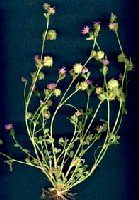View crop
View crop Data sheet EcoPortTrifolium resupinatum
 |
|
| Notes |
|---|
| BRIEF DESCRIPTION An erect decumbent or prostrate, coarse, herbaceous legume branching from the base and reaching 15-30 cm in height, with prostrate stems attaining a length of 50-100 cm. It has pink-mauve, sweet-smelling flowers, ovoid pods and pale brown seeds. USES It is grown for forage, hay, green manure seeds and as an ornamental. GROWING PERIOD Annual or biennial legume. Sown in the fall it may produces feed in late winter and early spring, it flowers in April and fruits in May. It propagate itself by seed. COMMON NAMES Persian clover, Shaftal, Shaftal clover, Birdseye clover, Reversed clover, Reserved trefoil, Peshawar clover, Trefle de Perse, Trefle renverse, Qort, Goreida, Loeyna, Khaneyshe, Naflah, El nefel el farsi, Nafal, Nifil, Nafal ahmar, Qurt. FURTHER INF Scientific synonyms: T. bicorne, T. clusii, T. suaveolens. Persian clover is native of western Asia, Greece and Egypt. It thrives on wet, heavy soils in low areas and can be found on roadsides, in fields, waste places, humid grassy plains and lower mountains at elevations between sea level and 1500 m. Recorded green manure yields are about 40 t/ha, green forage yields are 25-50 t/ha and hay yields at 2.5-12 t/ha and seed yields from 150-300 kg/ha. | Sources |
| Grassland Index Roecklein J 1987 pp 170 [USE, DRA, TEXT] Heath M 1985 pp 144 [TEXT, DRA] Duke J 1981 pp 260-262 320 [DRA, KTMP, TEXT, RAIN, TEMP, PH] B-Lennard E 1984 pp 454 [SAL] Aronson J 1989 pp 66 Kernick M 1978 pp 623-656 [RAIN, KTMP, DEP, DRA, PH, TEXT, SAL] |